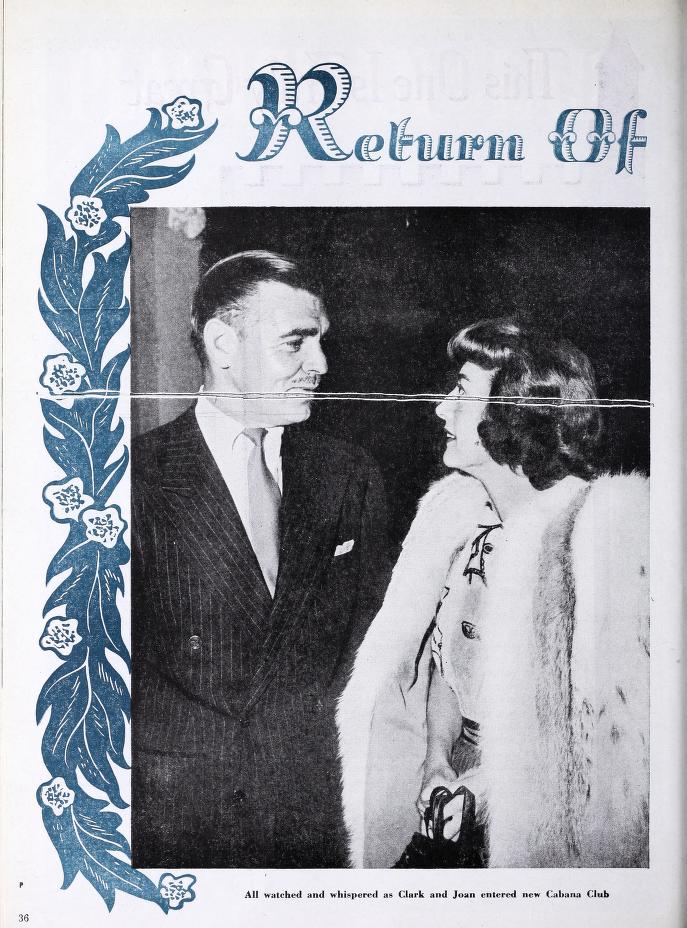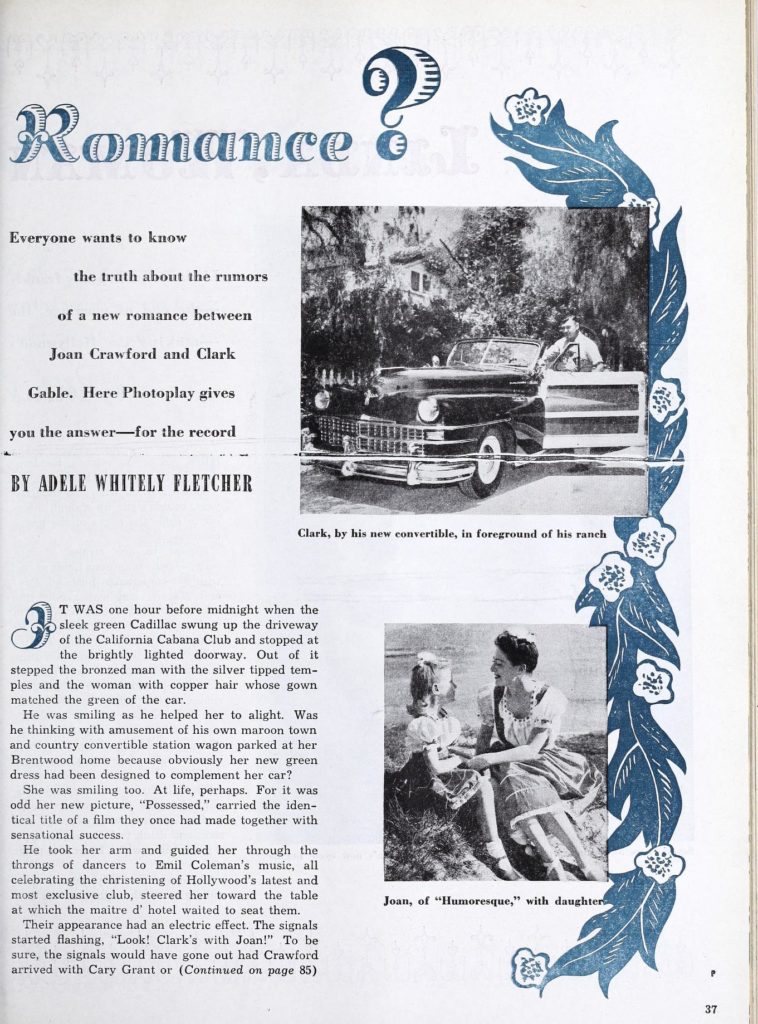1946: Return of Romance?
By Adele Whitely Fletcher
Photoplay, November 1946
Everyone wants to know the truth about the rumors of a new romance between Joan Crawford and Clark Gable. Here Photoplay gives you the answer—for the record
It was one hour before midnight when the sleek green Cadillac swung up the driveway of the California Cabana Club and stopped at the brightly lighted doorway. Out of it stepped the bronzed man with the silver tipped temples and the woman with copper hair whose gown matched the green of the car.
He was smiling as he helped her to alight. Was he thinking with amusement of his own maroon town and country convertible station wagon parked at her Brentwood home because obviously her new green dress had been designed to complement her car?
She was smiling too. At life, perhaps. For it was odd her new picture, “Possessed,” carried the identical title of a film they once had made together with sensational success.
He took her arm and guided her through the throngs of dancers to Emil Coleman’s music, all celebrating the christening of Hollywood’s latest and most exclusive club, steered her toward the table at which the maître d’hotel waited to seat them.
Their appearance had an electric effect. The signals started flashing. “Look! Clark’s with Joan!” To be sure, the signals would have gone out had Crawford arrived with Cary Grant or had Gable appeared with Rita Hayworth. But there wouldn’t have been any such quickening of emotions such stirring of memories. Because Crawford and Gable had once been Hollywood’s greatest potential romance and the town would love to see them together again.
By the time the two had reached their table the photographers swooped down upon them. Joan, briefly searching her companion’s face, caught the knowing grin, the imperceptible shrug, and straightaway invited six of the lens experts to join their table.
The banter between flash bulbs flew thick and fast, Clark interposing good-naturedly whenever there was a lull. “What’s the matter, boys, out of film?”
Joan paid him off in kind. When a friend dropped by the besieged table to observe that for two people to be seen together in Hollywood once was to be called a twosome and that Joan had better keep away from Errol Flynn, she countered, “I will. He’s much too young for me!”
Gable feigned indignation, “I beg your pardon!”
In this vein the evening rolled merrily along.
But the next morning the tongues began wagging, the press began rolling, the radio began chattering and those who follow Hollywood happenings suddenly sat up and asked, “What’s this? A new romance for Crawford and Gable?”
“New” is hardly the word. Joan and Clark have been special to each other from the day some years ago when they met and tested for their first picture, “Dance Fools Dance.” At that time Hollywood was in in furor over Clark because of the uncompromising gambler he had played in the film version of Adela Rogers St. Johns’ novel, “A Free Soul,” which starred Norma Shearer. “He comes from the stage,” they said in explanation of his instinctive timing.
Stage experience! Joan was impressed. Jittery too at the thought of working with him.
Clark also was impressed and jittery at the thought of working with Joan. On all sides he heard a brilliant career predicted for her.
“Miss Crawford!” He acknowledged the director’s introduction with a formal bow.
“Mr. Gable!” She rushed the words together in the fierce little way that then even more than now betokened her refusal to let it be known how shy she really was.
She was wearing a cotton house dress and low-heeled shoes. Clark towered above her, so far above her that, surprised out of her jitters, she cried: “My God, you’re big!”
An experienced siren couldn’t have conceived four words more likely to make a man remember.
Throughout the picture their friendship grew. Sitting on the sidelines of the set they used each other as a sounding board for all their thoughts. They talked about the theater and books, about the bouquet of wines and all the things they didn’t understand about life. No doubt anyone overhearing their conversation would have thought them incredibly corny. But they also would have realized they were wholly sincere.
For in their highly competitive town, with fame and fortune at stake, they dared not seem young or inexperienced or searching. So only with each other could they take off their masks; could Clark appear otherwise than a slightly politer facsimile of the tough guys he played on the screen, could Joan appear otherwise than a secure and smoothly sophisticated lady. Discovering each other in a way they also discovered themselves.
Clark was married to Rhea then. Joan was married to Douglas Jr. If they weren’t happy in their marriages they didn’t know it. So when rumors began to circulate about them they laughed and Joan promptly invited Rhea to lunch and they began visiting back and forth at each other’s homes.
However, later on, when Joan and young Doug returned from a holiday in Europe things were different. Joan was trying valiantly—sure death to any marriage—to keep things together. For when she married Douglas Fairbanks Jr., she had made her vows of faithfulness and forbearance with the solemnity of a reformed Hey Hey girl.
Clark and Rhea, too, had changed towards each other.
So, intrinsically unhappy and lonely, Joan and Clark met again to make “Possessed.” The first one on the set in the mornings waited for the other to arrive. More and more their chairs stood side by side. More and more they talked of all the things in life they could less and less understand.
“Clark’s an old softy!” she said at this time, meaning no doubt, to make an amusing revelation. But her voice went tender, making it a romantic revelation instead. It still does even when she says of some other man, “He’s kind of Clark Gable-ish…” And Clark, speaking of Joan, for years has tried to be noncommittal when he’s said, “She’s quite a gal!”
The crew on the “Possessed” set were the first to know Joan and Clark were in love. They knew it probably before Joan or Clark did themselves. Then items began appearing in the columns. But where Joan once had laughed down similar rumors she now enraged and denied everything.
“Can there be no friendship in Hollywood?” she demanded emotionally.
Those who knew Joan and Clark best insisted they never saw each other except at the studios and at parties. At parties, however, you always found them on the same side of the room, on the same side of a discussion or rushing excitedly to each other to share something amusing; an inevitable sign that a man and a woman are important to each other; more so sometimes than either one of them yet realizes.
This was Joan’s and Clark’s time, of course. But neither of them was quite ready for the divorce and publicity they both faced later on.
There was, so far as anyone knows, no grand renunciation between them. They simply and gradually moved away from each other, back into the shelter of their marriages.
The romanticists will tell you—and they may be right—that this was a great pity, that Joan and Clark then were made for each other and, had they followed their hearts, would be two different people today, two happier and more fulfilled and secure people. And there is no doubt in the minds of all who have observed them through the years that there never has been a time, even when they have been emotionally involved with others, that they haven’t been important to each other, that they haven’t paused instantly at the sound of the other’s call or voice or even at the casual mention of the other’s name.
Joan was in New York when Carole Lombard Gable’s plane crashed. For years her path and Clark’s had not crossed except in the most casual manner. Married to Franchot Tone in the meantime, Joan also had become somewhat the smooth sophisticate she once only had pretended to be. Nevertheless, her grief for Clark was something she did not even try to hide.
It was just before Joan married Phil terry that gossips once more began noticing Clark’s car parked in front of her house in Brentwood. But in this story of frustration again the time was not right. Clark was the top man on the screen. Joan was in her slump. Above all, she needed to re-establish herself and to be with those who worshiped her blindly and so soothed her ego. All of which is understandable. For it is not in the human pattern not to be hurt and not be determined to prove yourself all over again when you’re looked upon as a glamorous queen one day and the next you’re kept waiting outside producers’ offices while newcomers are given parts you would cherish.
Earlier, of course, when both Joan’s and Clark’s positions were dominant and strong, it had been all right for them to confess to each other their underlying sense of insecurity and their sensitive fears. Not now.
So Clark went away. Again, inevitably, the distance between him and Joan widened. She had her greater absorption in her career, her delightful adopted children with their pretty manners, her beautiful white house with its exquisite white drawing room. Clark had his definitely lesser interest in his career and his informal life on his ranch. And when he said farewell to Hollywood to fly in enemy skies and Joan married Phillip Terry the distance was even greater than before.
Not too great, however. For again their paths were destined to cross. It was after Clark returned to civilian life and Joan’s marriage to Phillip Terry was on the rocks. This time Louis B. Mayer provided the springboard by seating Joan and Clark next to each other at a dinner party he was giving. That gentlemen has been known to foster romance more than once.
For a while it looked as if the friendly hypo might be taking, for thereafter the Gable car was seen on occasions making its way over the hills from the Valley to Brentwood. And Hollywood, frequently hard-boiled over the heart affairs of its fellow citizens, really rooted for this one. Hadn’t the right time arrived at last for the bug guy who had known tragedy, made a fine record in the war only to return to an empty heart, and the woman who alone won top acclaim for her courageous comeback?
Then came the opening of the California Cabana Club when Joan and Clark created a social climax by attending together. An answer had to be given and Joan gave it. “I’m amazed Clark and I caused such a flurry by appearing together at the Cabana Club. I thought everyone knew we saw each other occasionally.”
This could be another one of those evasions out of the mouths of Hollywood stars. It could be—but isn’t. Theirs is not the romance Hollywood would like to have it—not as things stand at the moment. Again, it’s a question of the wrong timing; Gable, fed up with pictures despite the financial success of “Adventure,” his future course unclear even to himself, Joan, with her feet firmly on the road to perhaps a second Oscar.
But who is to say that the timing might not one of these days be right?

